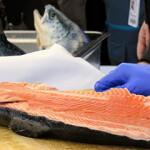Satlink leading shift from human fishery observers to land-based electronic monitoring

Madrid, Spain-based Satlink, which specializes in technological solutions and developments based on satellite communications, has launched a program designed to train on-board human fishery observers to perform fishery monitoring through video data and satellite imaging.
The program will give regional fishery management organizations (RFMOs), governments, and fishing companies a method of observational compliance that sidesteps complications regarding placing observers on-board vessels during the coronavirus pandemic.
Among other issues, some RMFOs, such as the Western and Central Pacific Commission, have suspended the placement of observers on-board vessels due to COVID-19 health concerns, which has had the result of scaling back monitoring activities in some of the world’s most productive fishing grounds. According to Satlink, around 800 observers have lost work as a result of the suspension.
“The Satlink EM training program would not only maintain the jobs of the observers in many parts of the Pacific, but allow for more vessels to be monitored electronically, thus increasing the number of these professionals needed for video review,” the company said in a press release. “Based on more than 5,000 longline and purse-seine vessels operating there, it is estimated that at least 25 percent more human observers will be needed. Importantly, this training would expand the use of EM and improve existing fishery monitoring and compliance activities that safeguard sustainable fishing practices which are at risk because of the absence of observers on-board.”
Satlink currently has installations on 110 vessels from nine countries, operating in the Atlantic, Pacific, and Indian oceans, and operates 20 video analysis systems at electronic monitoring (EM) training centers. The company’s EM systems are capable of continuously recording the activity on fishing vessels to ensure responsible fishing practices and treatment of crew. Additionally, since 2014, the company has trained more than 150 professionals on fishery data analysis using satellite observation.
“With Satlink's EM technology, human observers can generate from video review accurate reports on the composition of catches, size, bycatch, and confirm fishing zones,” the company said.
The Food and Agriculture Organization of the United Nations (FAO) recently pushed to improve and expand the use of electronic monitoring systems for fisheries to ensure ethical and sustainable practices in global fisheries. According to Satlink President Faustino Velasco, fleets with deficient data collection systems must progressively adapt their fishing programs to international standards, such as those recommended by the FAO and those mandated by the European Union, which subjects its fleet to strict surveillance regulations.
“These electronic monitoring systems are not only the main source of precise, reliable, and verified data for the development of better selective fishing practices and the establishment of measures that ensure the sustainability of the stocks, but also for the fixation and generation of employment on land and the improvement of working conditions for observers in terms of safety on board the vessels, conciliation and professional development,” Velasco said.
Photo courtesy of Satlink






Share